Can you tell our readers a little about yourself and what you have been doing in the last year?
Absolutely. I was born to a mother from Korea and a Black father from Louisiana and am now the proud mother of five very energetic boys. I grew up in Colorado Springs, Colorado before attending Brigham Young University (BYU) on a music scholarship where I studied string bass performance and English with a creative writing emphasis. During my college years, I worked as a string instrument technician for BYU’s instrument office, also teaching lessons and freelancing as a bassist. I played with the Orchestra at Temple Square, subbed with the Ballet West Orchestra, and dabbled in jazz.
After college, my husband and I moved all over the country from California to Oregon to New York to Missouri until 2017 when we moved to Salt Lake City. While in Oregon, I played with the Vancouver Washington Symphony and worked for Kennedy Violins as a luthier.
Before moving to Utah, I created a children’s music program in 2016 called Yoga Storytime and Songs as my alter ego, Lizzy Luna (lizzyluna.com). Unfortunately, due to COVID-19, I haven’t been doing live performance sessions, but the Salt Lake City Public Library commissioned a few Lizzy Luna videos available online (https://library.biblioboard.com/anthology-collection/949df94e-d025-4d47-8f5b-78e057426694/4240487a-94ac-4545-8a91-175023b7980e).
Currently I’m a member of the Ballet West orchestra on string bass. Also I’ve become quite involved as an activist through art, serving as a board member of the Utah Black Artist Collective and board director of the new Utah Black History Museum.
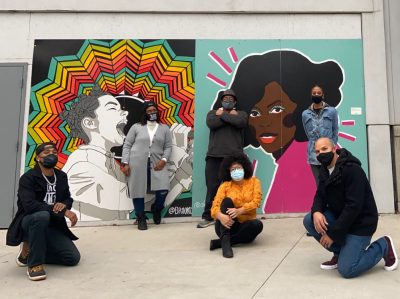
The Utah Black Artists Collective Board of Directors
From left to right: Bashaun Williams, Schkyra Mourning, Jayrod Garrett, Liz Lambson, Katlyn Addison, Daney Nelson
Most recently I painted the cover of SLUG Magazine’s “Amplify Black Voices” April issue (https://www.slugmag.com/wp/wp-content/uploads/2021/03/388-SLUG-April-2021-32pg-WEB.pdf), which was a really fun project for a publication also featuring the Utah Black History Museum bus I painted along with artist Gretel Tam.
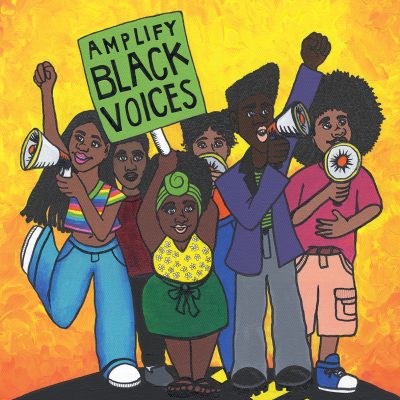
Artwork for the April 2021 issue cover of SLUG Magazine
What are some of the barriers you feel you face as a Black artist in Utah?
I think one of the largest barriers I face, and Black people like me face, is a general reluctance for people, particularly white audiences, to admit when biases influenced their decisions about me.
I had an interesting experience where I tried to hire a nanny who happened to be white, and she never showed up for her interview. Interestingly enough, I ran into her at an open mic night at a comedy club. She got on stage and started telling a story about going on vacation with a family and getting so mad at the kids she started cussing them out. I asked the emcee to put me on next and said, “Funny thing, I went to Care.com and I found someone I really wanted to hire, but she totally ghosted me… Oh, hey Karen! I don’t even have to interview you now that I know you’ll just swear at my kids.” Her name was actually Karen!
Afterward, when I had a chance to meet her, she apologized profusely, admitting to judging me by my appearances. As a white woman she, either consciously or subconsciously, didn’t want to be a nanny for a woman of color. She admitted to it, but there are many people who make judgements this way who either don’t recognize their biases or blatantly refuse to admit to them.
I think breaking down barriers for Black people starts when we finally have the courage to admit when we are wrong. I would encourage everyone to find that courage within themselves.
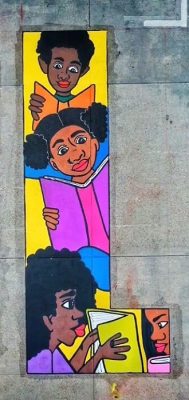
The “L” portion of Lambson’s contribution to the Salt Lake City Black Lives Matter mural
Last summer, you participated in painting sections of the Black Lives Matter mural in front of Salt Lake City’s City Hall. What would you say was the inspiration for your designs in that mural?
Even as a young girl, I’ve always loved the visual arts — especially painting and drawing with vibrant colors. When I saw the call for artists for the mural, I knew that not only are there not many Black people in Utah, but more specifically, there aren’t many Black artists. So, I honestly felt an obligation to submit something for this mural as a representative from our Black community. I was pretty worried to submit something because I have five children and knew this was going to be a big project. However, being selected to be on the team of artists painting that mural led to so many opportunities that really defined this last year for me.
In my life I have witnessed and experienced a belief — a racist belief — that Black people are unintelligent. Whenever I meet someone new, I find myself immediately opening my mouth, hoping to establish that I am an intelligent person worthy to be included in conversation. I designed the letter “L” with a plan to illustrate Black children reading literature by Black authors, challenging the fallacy of this belief and showing that Black children who have access to quality education can and do achieve great things alongside their white peers. We are intelligent and worthy of opportunities to reach our potential.
Also, huge shout out to Kathryn Richards and Katlyn Addison for helping me paint that letter and for their support during that project.
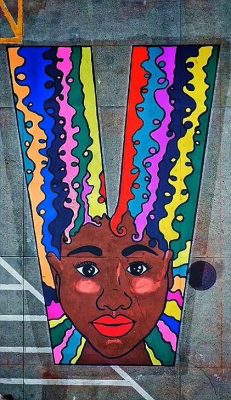
The “V” portion of Lambson’s contribution to the Salt Lake City Black Lives Matter mural
The other letter I painted, the “V” in the middle of the mural, was a portrait of a Black woman’s face with brightly-colored, curly hair flowing freely. In my life, I have personally experienced prejudice and criticism while wearing my natural hair. It took me a very long time to finally accept my hair and stop straightening, manipulating, and “fixing” it.
Just within the last year or two, there have finally been laws and policies put in place to protect Black people’s right to wear their natural hair in the workplace. In addition, I know that myself and other Black people have their hair labeled as “wild,” a word harkening back to colonial attitudes and perceptions of Black people that are completely wrong. So, with this piece, I wanted to communicate to Black men, women, children, and everyone, that they do not have to try and conform or look white to be accepted. It’s not necessary. Black hair is beautiful.
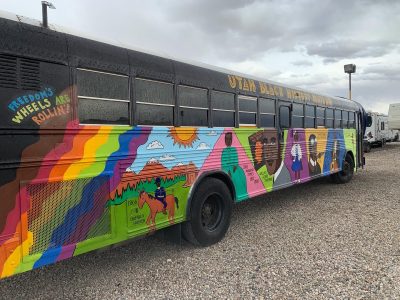
The mobile Utah Black History Museum – murals by Artist Liz Lambson
As a member of the Board of Directors for the new Utah Black History Museum, what do you see as the significance of the museum in relation to the state of Utah?
There are citizens of Utah who have never befriended or even met a Black person. So, for a lot of our community members, it may seem as if Black history is irrelevant, but that is absolutely not the case. It is especially important to share and teach Black history in areas that are geographically separated from more diverse metropolitan areas.
Racism will persist and not be overcome until an important first step is taken: the step to address ignorance. The Utah Black History Museum is a mobile museum that can reach even rural areas in the state. It features an exhibit highlighting Black people and events that are relevant to Utah’s history. To learn Black History is to teach people the value and significance of people who are not like you, especially Black people whose value has not been historically recognized. History repeats itself, making it important to learn both the tragic and beautiful parts of the past for our learning and benefit as our actions shape the future. Instead of fearing differences, we need to learn to embrace them.
For example, in Utah there is an enormous sense of pride for pioneers, especially Mormon pioneers honored by a dedicated holiday, Pioneer Day. However, very few people know that slaves were brought alongside the pioneers and there is a significant slave history within the state of Utah. In the mobile Black History Museum, a figure we highlight is Jane Manning James, the first Black woman recorded to immigrate to Utah. She was a servant to Joseph Smith’s family and an extremely important figure for the Church of Jesus Christ of Latter-day Saints.
The demographics of Salt Lake City, and the state in general, are changing. It is more important than ever to provide accessible ways for everyone, especially young people, to learn about people who are different from them, to just see what life is like for people who look and live differently than they do. The goal of the Utah Black History Museum is to educate and share the stories of overlooked historical figures. Learning about the people who came before us is truly life-changing. (You can learn more about the museum at ubhm.org.)
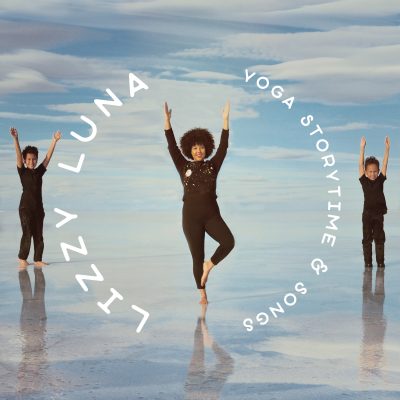
Cover art for Artist Liz Lambson’s program “Yoga Storytime & Songs”
How can our readers connect with you and see more of your work?
I’m on Facebook and Instagram, as are these great organizations I’m involved in (links below). Check out their websites to learn more about connecting and volunteering in our community. Thank you so much!
Lizzy Luna – Facebook – https://www.facebook.com/lizzyluna.yoga.56
Lizzy Luna – Instagram – https://www.instagram.com/lizzylunayoga/
Liz Lambson – Instagram – https://www.instagram.com/lizzylambson/
Lizzy Luna Website – https://www.lizzyluna.com/
Utah Black History Museum – http://www.ubhm.org/
Utah Black Artists Collective – https://ublac.org/
Liz Lambson Artist Profile – NowPlayingUtah.com – https://www.nowplayingutah.com/artist/liz-lambson/
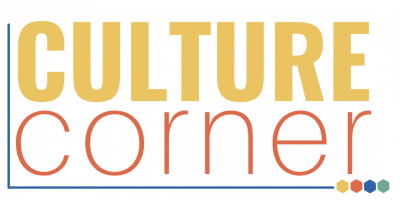
In Utah, there is a rich cultural landscape that is thriving, yet seldom seen and experienced. Take a few minutes to relax and connect with local artists all across Utah. Hear their most rewarding experiences, the struggles they face, and what inspires them to create their art.